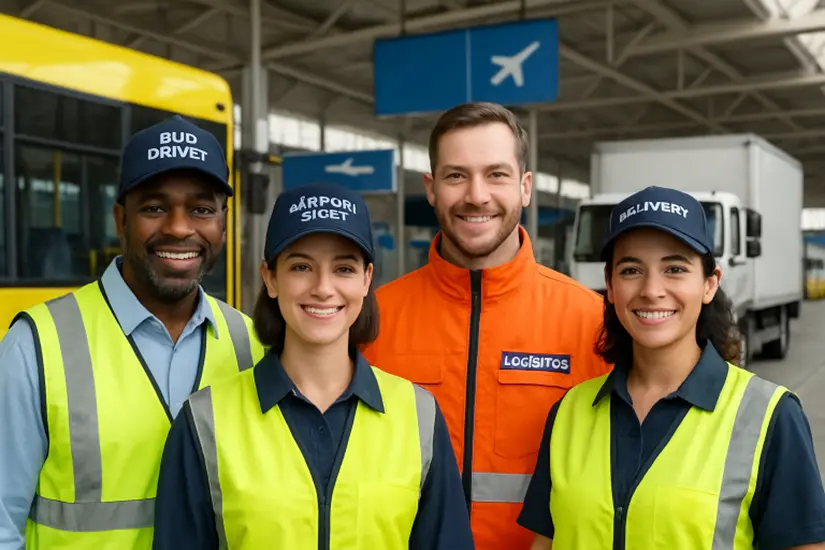Within the transportation sector, choosing the right uniform goes far beyond visual uniformity; it’s crucial for the daily safety and effectiveness of your workforce. Outfitting employees with reliable transportation uniforms can immediately reduce job-related risks, while also contributing to the comfort and confidence that drive higher standards of performance. High-quality workwear at airports, bus terminals, and logistics is essential for operational success and employee well-being. The right uniform protects workers from hazards and improves visibility in risky environments. Using modern, durable attire shows a company’s commitment and fosters a safer, more productive culture. Investing in quality uniforms is strategic, as it reduces incidents, lasts longer, and supports retention. Features like ergonomic design and eco-friendly materials offer long-term benefits, enhancing efficiency, professionalism, and sustainability in transportation.
Enhancing Safety with High-Visibility Uniforms
Professional transportation environments are busy with vehicles and machinery, creating hazards for workers. High-visibility uniforms help reduce accidents by making workers more noticeable, even in poor conditions. These uniforms use fluorescent materials and retroreflective tape for visibility from a distance and by moving vehicles. ANSI standards, like ANSI/ISEA 107-2020, specify performance requirements, and OSHA provides additional guidance at osha.gov. Employers investing in compliant high-visibility workwear see fewer safety incidents, meeting regulations and showing care for worker safety—boosting trust and reputation.
Boosting Productivity Through Comfortable Workwear
Fatigue, discomfort, and distraction are common risks when employees are provided with ill-fitting or inferior uniforms. Today’s best workwear integrates ergonomic tailoring, flexible stitching, and innovative fabric technologies to ensure workers enjoy greater mobility and lower fatigue. Moisture-wicking blends, breathable textiles, and adjustable panels help to keep workers cool and focused, especially during long shifts or challenging weather conditions. According to Safety+Health Magazine, properly fitted uniforms can directly decrease workplace injury rates by ensuring employees are not distracted or hindered by their attire.
Organizations that prioritize comfort in their transportation uniforms see benefits not only in worker productivity, but also in morale. When employees are comfortable and confident in their appearance, they’re more likely to deliver outstanding service.
Financial Benefits of Investing in Quality Uniforms
While high-quality uniforms represent a higher upfront spend, they are a worthwhile investment for businesses focused on long-term success. Durable garments withstand the rigors of daily use and frequent laundering, which is common in the transportation sector. This durability leads to fewer replacements and less waste, saving organizations money over time. There’s also a significant safety dividend: as injury rates decline with better-protected workers, employers can avoid costly disruptions, medical expenses, insurance claims, and potential legal actions.
Industry data suggests that every $1 invested in injury prevention can translate into $4–$6 in direct savings. Reduced turnover is another financial plus, as employees are less likely to leave positions where they feel valued and protected, further strengthening operations over time.
Maintaining Professionalism and Brand Identity
Uniforms do more than provide protection—they are powerful tools for communicating professionalism and reinforcing brand identity. Well-designed and consistently branded workwear not only builds trust among customers and the public but also fosters a sense of belonging among team members. Uniforms can quickly identify employee roles in busy transportation hubs, streamlining communication and service.
Establishing a strong brand image through uniforms conveys that your organization values both customers and employees. This investment in appearance and cohesion often leads to increased workforce pride, enhanced teamwork, and greater customer satisfaction.
Prioritizing Comfort and Sustainability
The demand for sustainable business practices now extends to uniform choices. Many transportation organizations are specifying uniforms made from recycled or organic fibers, or investing in eco-friendly laundry solutions. These choices help reduce environmental impact and support the organization’s sustainability goals. Breathable, stretch-enhanced materials ensure team members stay comfortable all day, helping to reduce fatigue and absenteeism among staff.
Choosing sustainable uniforms isn’t just good for the planet; it can also enhance your company’s employer brand as more job seekers and clients prioritize environmental responsibility in their decision-making.
Conclusion
High-quality uniforms are foundational to safety, productivity, and professionalism in the transportation sector. Organizations that choose well-designed, durable, and sustainable workwear protect their workforce, elevate public perception, and realize long-term cost savings. With the right approach to uniforms, companies can confidently meet operational demands while advancing their commitment to employee welfare and sustainability.
Also Read-Vidwud AI: Transforming Online Body Swap and Talking Photo Technology



